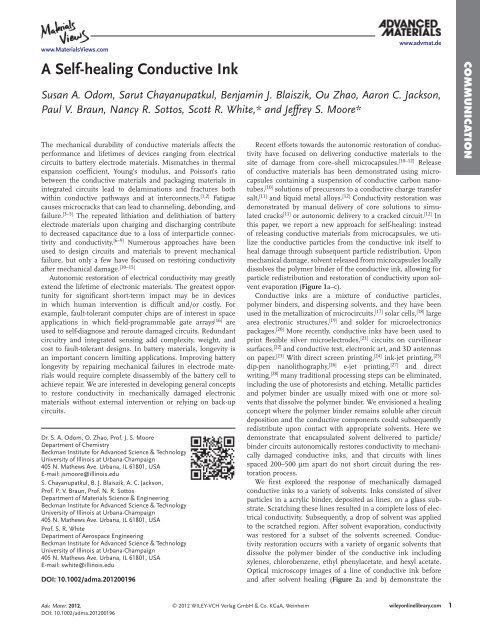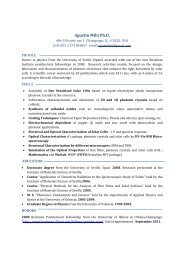A Self-Healing Conductive Ink - Paul Braun Research Group ...
A Self-Healing Conductive Ink - Paul Braun Research Group ...
A Self-Healing Conductive Ink - Paul Braun Research Group ...
Create successful ePaper yourself
Turn your PDF publications into a flip-book with our unique Google optimized e-Paper software.
www.MaterialsViews.com<br />
A <strong>Self</strong>-healing <strong>Conductive</strong> <strong>Ink</strong><br />
Susan A. Odom , Sarut Chayanupatkul , Benjamin J. Blaiszik , Ou Zhao , Aaron C.<br />
<strong>Paul</strong> V. <strong>Braun</strong> , Nancy R. Sottos , Scott R. White , * and Jeffrey S. Moore *<br />
The mechanical durability of conductive materials affects the<br />
performance and lifetimes of devices ranging from electrical<br />
circuits to battery electrode materials. Mismatches in thermal<br />
expansion coeffi cient, Young’s modulus, and Poisson’s ratio<br />
between the conductive materials and packaging materials in<br />
integrated circuits lead to delaminations and fractures both<br />
within conductive pathways and at interconnects.<br />
Dr. S. A. Odom , O. Zhao , Prof. J. S. Moore<br />
Department of Chemistry<br />
Beckman Institute for Advanced Science & Technology<br />
University of Illinois at Urbana-Champaign<br />
405 N. Mathews Ave. Urbana, IL 61801, USA<br />
E-mail: jsmoore@illinois.edu<br />
S. Chayanupatkul , B. J. Blaiszik , A. C. Jackson ,<br />
Prof. P. V. <strong>Braun</strong> , Prof. N. R. Sottos<br />
Department of Materials Science & Engineering<br />
Beckman Institute for Advanced Science & Technology<br />
University of Illinois at Urbana-Champaign<br />
405 N. Mathews Ave. Urbana, IL 61801, USA<br />
Prof. S. R. White<br />
Department of Aerospace Engineering<br />
Beckman Institute for Advanced Science & Technology<br />
University of Illinois at Urbana-Champaign<br />
405 N. Mathews Ave. Urbana, IL 61801, USA<br />
E-mail: swhite@illinois.edu<br />
DOI: 10.1002/adma.201200196<br />
[ 1 , 2 ]<br />
Fatigue<br />
causes microcracks that can lead to channeling, debonding, and<br />
failure. [ 3–5 ] The repeated lithiation and delithiation of battery<br />
electrode materials upon charging and discharging contribute<br />
to decreased capacitance due to a loss of interparticle connectivity<br />
and conductivity. [ 6–9 ] Numerous approaches have been<br />
used to design circuits and materials to prevent mechanical<br />
failure, but only a few have focused on restoring conductivity<br />
after mechanical damage.<br />
[ 10–15 ]<br />
Autonomic restoration of electrical conductivity may greatly<br />
extend the lifetime of electronic materials. The greatest opportunity<br />
for signifi cant short-term impact may be in devices<br />
in which human intervention is diffi cult and/or costly. For<br />
example, fault-tolerant computer chips are of interest in space<br />
applications in which fi eld-programmable gate arrays<br />
used to self-diagnose and reroute damaged circuits. Redundant<br />
circuitry and integrated sensing add complexity, weight, and<br />
cost to fault-tolerant designs. In battery materials, longevity is<br />
an important concern limiting applications. Improving battery<br />
longevity by repairing mechanical failures in electrode materials<br />
would require complete disassembly of the battery cell to<br />
achieve repair. We are interested in developing general concepts<br />
to restore conductivity in mechanically damaged electronic<br />
materials without external intervention or relying on back-up<br />
circuits.<br />
Adv. Mater. 2012,<br />
DOI: 10.1002/adma.201200196<br />
[ 16 ]<br />
are<br />
www.advmat.de<br />
Jackson ,<br />
Recent efforts towards the autonomic restoration of conductivity<br />
have focused on delivering conductive materials to the<br />
site of damage from core–shell microcapsules. [ 10–12 ] Release<br />
of conductive materials has been demonstrated using microcapsules<br />
containing a suspension of conductive carbon nanotubes,<br />
[ 10 ] solutions of precursors to a conductive charge transfer<br />
salt, [ 11 ] and liquid metal alloys. [ 12 ] Conductivity restoration was<br />
demonstrated by manual delivery of core solutions to simulated<br />
cracks [ 11 ] or autonomic delivery to a cracked circuit. [ 12 ] In<br />
this paper, we report a new approach for self-healing: instead<br />
of releasing conductive materials from microcapsules, we utilize<br />
the conductive particles from the conductive ink itself to<br />
heal damage through subsequent particle redistribution. Upon<br />
mechanical damage, solvent released from microcapsules locally<br />
dissolves the polymer binder of the conductive ink, allowing for<br />
particle redistribution and restoration of conductivity upon solvent<br />
evaporation ( Figure 1 a–c).<br />
<strong>Conductive</strong> inks are a mixture of conductive particles,<br />
poly mer binders, and dispersing solvents, and they have been<br />
used in the metallization of microcircuits, [ 17 ] solar cells, [ 18 ] large<br />
area electronic structures, [ 19 ] and solder for microelectronics<br />
packages. [ 20 ] More recently, conductive inks have been used to<br />
print fl exible silver microelectrodes, [ 21 ] circuits on curvilinear<br />
surfaces, [ 22 ] and conductive text, electronic art, and 3D antennas<br />
on paper. [ 23 ] With direct screen printing, [ 24 ] ink-jet printing, [ 25 ]<br />
dip-pen nanolithography, [ 26 ] e-jet printing, [ 27 ] and direct<br />
writing, [ 28 ] many traditional processing steps can be eliminated,<br />
including the use of photoresists and etching. Metallic particles<br />
and polymer binder are usually mixed with one or more solvents<br />
that dissolve the polymer binder. We envisioned a healing<br />
concept where the polymer binder remains soluble after circuit<br />
deposition and the conductive components could subsequently<br />
redistribute upon contact with appropriate solvents. Here we<br />
demonstrate that encapsulated solvent delivered to particle/<br />
binder circuits autonomically restores conductivity to mechanically<br />
damaged conductive inks, and that circuits with lines<br />
spaced 200–500 μ m apart do not short circuit during the restoration<br />
process.<br />
We fi rst explored the response of mechanically damaged<br />
conductive inks to a variety of solvents. <strong>Ink</strong>s consisted of silver<br />
particles in a acrylic binder, deposited as lines, on a glass substrate.<br />
Scratching these lines resulted in a complete loss of electrical<br />
conductivity. Subsequently, a drop of solvent was applied<br />
to the scratched region. After solvent evaporation, conductivity<br />
was restored for a subset of the solvents screened. Conductivity<br />
restoration occurrs with a variety of organic solvents that<br />
dissolve the polymer binder of the conductive ink including<br />
xylenes, chlorobenzene, ethyl phenylacetate, and hexyl acetate.<br />
Optical microscopy images of a line of conductive ink before<br />
and after solvent healing ( Figure 2 a and b) demonstrate the<br />
© 2012 WILEY-VCH Verlag GmbH & Co. KGaA, Weinheim wileyonlinelibrary.com 1<br />
COMMUNICATION




